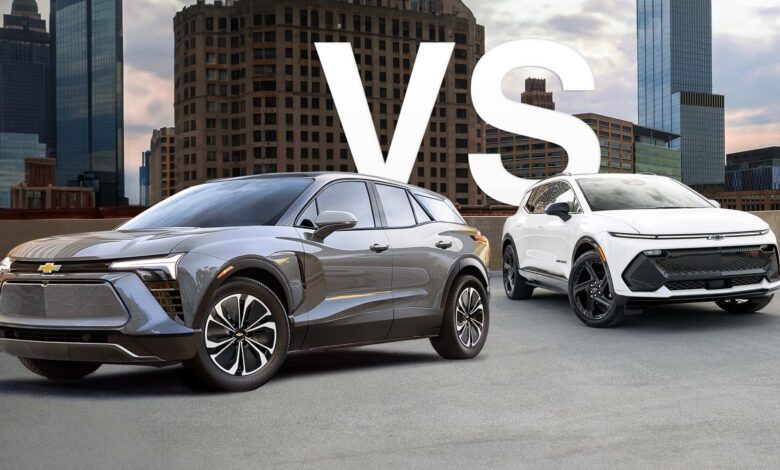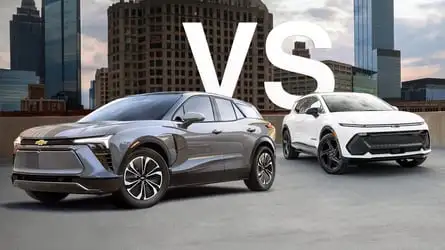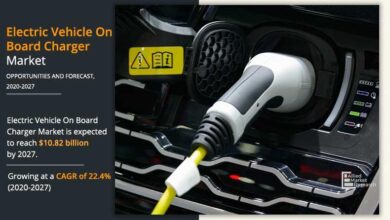2024 Chevrolet Equinox EV Vs. Blazer EV: Which Should You Buy?

These two vehicles share a platform and battery technology, but they differ in size, styling and, more importantly, price.

May 31, 2024 at 4:30pm ET
Chevrolet is offering two seemingly very similar electric crossovers in the form of the 2024 Equinox EV and the 2024 Blazer EV. In fact, both ride on the same GM BEV3 version of the Ultium platform, get their power from Ultium batteries and are motivated by Ultium Drive motors.
In theory, the differences should be obvious. Besides looking quite different, they are ostensibly in separate classes, with the Blazer EV being the larger and more expensive choice, as well as the more performance-focused one. It gets more power as standard, has a faster DC fast charging speed in some trims, and will be available with front-, rear- or all-wheel drive—unlike the Equinox, which has either front- or all-wheel drive.
But many prospective EV buyers have pointed out that the two may not be as far apart as GM expected—especially once you factor in the many trim levels involved with both, and the tax credit discounts as well.
So which one should you consider? Let’s break it down so that you can more easily choose between the two.
Size And Space
The 2024 Chevy Blazer EV rides on a 5.5-inch longer wheelbase than the 2024 Equinox EV—121.8 inches compared to 116.3 inches, respectively. It’s also about 1.7 inches longer overall (192.2 inches versus 190.5 inches) and about an inch wider. In person, the Blazer EV does have a larger presence than the Equinox EV does. The Blazer EV is the taller of the two, with a total height of 65 inches compared to 64.8 inches.
The Equinox EV has very different proportions, though, and it looks like a vehicle designed to maximize practicality at the expense of looking sporty; just look at how big its overhangs are compared to the Blazer EV.
Hop inside the Equinox EV, and you may be surprised by how cavernous it feels. It feels more airy than the Blazer’s cabin, and in some metrics, it is genuinely bigger. You get more front legroom, rear headroom and cargo volume behind the second row of seats in the Equinox.
The level of interior room is not directly proportional to the exterior size difference, and in some areas, the smaller Equinox EV actually offers more space. It can accommodate up to 26.4 cubic feet of cargo, while the Blazer is limited to 25.5 cu-ft. Fold down the rear seats, though, and it’s the Blazer that offers more space, with a rating of 59.1 cu-ft to the Equinox’s 57.2 cu-ft.
Power And Range
Even though GM initially announced the Chevy Blazer EV was going to be available with power going to either the front, rear or all four wheels, it decided to make the initially available base model all-wheel drive. The entry-level Blazer EV RS has a dual-motor setup that provides 288 horsepower and 333 pound-feet of torque, which is enough for a 0–60 mph acceleration time of six seconds.
It comes with an 85-kilowatt-hour battery pack that provides 279 miles of EPA range and it can charge at up to 150 kilowatts from a DC fast charger. Chevrolet says that’s enough to add 78 miles in around 10 minutes of charging, while its onboard 11.5 kW AC charger will add about 31 miles of extra range per hour.
You can get the Blazer EV with more power and range if you opt for the RS RWD variant, which gets a single 340 hp motor with 325 lb-ft of torque driving the rear wheels and a larger 102 kWh battery pack. That bumps the EPA range to 314 miles thanks to the 17 kWh of extra capacity. That battery also charges up to 190 kW; it is unavailable on the Equinox EV.
For even more performance, you can opt for the upcoming Blazer EV in SS trim, which has a dual-motor all-wheel drive setup with a combined 557 hp and 648 lb-ft. That’s enough for a 0–60 mph run in under four seconds, giving this vehicle the performance you expect from a vehicle that looks as bold and aggressive as it does.
A GM spokesperson confirmed to InsideEVs that despite its similarities to the Equinox EV, a FWD version of the Blazer EV will be available this year.
The Equinox EV isn’t designed to impress with its performance in the same way as the Blazer EV is, and it has to make do with a single-motor front-wheel drive setup in base form. With an output of 213 horsepower and 236 lb-ft of torque, it won’t pin you to your seat, but it should be quick enough for everyday driving even when fully loaded.
With the optional eAWD dual-motor setup, which uses a different lower-power front motor and another motor driving the rear wheels, you get a combined power output of 288 hp, and torque gets a bump to 333 lb-ft. GM lists the 0-60 mph sprint time for the all-wheel-drive Equinox EV as 5.9 seconds, which sounds like plenty for a vehicle of this type.
Only one battery is available for the Chevy Equinox EV, the same 85 kWh pack that powers the base Blazer EV (as well as the mechanically related Honda Prologue), but since it’s powering a smaller, lighter vehicle, it gets a better range rating than the Blazer with the big battery. The EPA rates the Equinox EV at 319 miles, a number that should eliminate all traces of range anxiety in this vehicle. Going dual-motor in the Equinox EV cuts the range to 285 miles.
The Equinox EV is slower to charge than the Blazer, but with a peak DC fast charging rate of 150 kW, the vehicle should gain 77 miles of range in 10 minutes, just slightly less than its bigger, sportier brother. It will gain 34 miles of range per hour when using its 11.5 kW AC charger, which will go up to 51 miles per hour for next year’s 3RS trim, which will get a more powerful 19.2 kW onboard charger.
Pricing And Features
Here’s where things get a little strange, and where shopping around will serve you well.
The Chevrolet Blazer EV starts at $50,195 before any rebates and discounts. You get the base eAWD model with 288 hp and 279 miles of range for that. The LT trim comes with 19-inch wheels, an 11-inch digital driver’s display, a big 17.7-inch Google-powered infotainment screen, and Chevrolet Safety Assist (which includes six advanced active safety features and is standard on the Equinox EV).
Move up to 2LT, and the vehicle gets grille illumination, heated front seats and a heated steering wheel, and the option to spec Super Cruise and more advanced driver assistance systems.
The RS eAWD model starts at $54,595 and makes the faux grille black and the Chevy logo illuminated, and the size of the wheels goes up to 21 inches. If you want the more powerful RS RWD model, that will start at $56,170.
At the same time, the top-tier SS will start at over $65,000 and feature unique front and rear fascias, bigger 22-inch wheels and the Wide Open Watts performance mode that makes the four-second 0-60 mph acceleration time possible.
The price of the entry-level FWD Blazer EV has not been announced yet, but GM has said it will start under $50,000. The Chevy Blazer EV is eligible for the $7,500 federal tax credit or a GM-added discount called the Ultium Promise Bonus Cash, which means the entry-level variant could be had for around $43,000. The base Chevy Equinox EV, which starts at $41,900, should be about $33,600 with the tax credit applied.
The upcoming base Equinox EV 1LT will be even cheaper at around $35,000 before any tax credits, and will feature the same 17.7-inch screen as the Blazer EV with the same Google-based operating system. It gets 19-inch wheels as standard, but you can go up to 21 inches in higher trim levels.
In other words, right now you can get a a well-equipped Blazer EV in the mid-$40,000 range (including tax credits, and with some deals we have seen, perhaps even less) while the smaller and less powerful Equinox EV can be had for about as much—though prices on those can dip into the mid-$30,000 range thanks to tax credits as well.
Driving Impressions
We’ve recently had the chance to drive the Chevy Equinox EV and were pleasantly surprised by its blend of qualities. It’s not outstanding in any particular area, but it’s a solid all-round EV that you can get for a very affordable price when you factor in incentives and rebates. It drives well, has oodles of interior space and decent equipment, and it’s probably the best GM EV since the Bolt. It’s not just good for an EV; it’s unquestionably better than the gas-burning Equinox in every way.
The same can’t be said of the Blazer EV, which is a direct rival to some of the most talented electric crossovers on the market, which include the Tesla Model Y, Hyundai Ioniq 5 and the upcoming Polestar 4.
It’s a bit more expensive than some rivals, but heavier too, and at least until the SS version arrives it may not offer enough to justify the difference. When we drove the Blazer EV RS late last year, we thought it was a good vehicle, but it wasn’t one we would choose over some American, Korean, or European rivals. Maybe next year’s new and more affordable front-wheel drive base model might sway us its way.
The Equinox EV made a far better overall impression after the first drive. Even though it’s a bit smaller than the Blazer, it still rivals the same EVs, and it is affordable enough to be seriously taken into consideration, especially when you apply the federal tax credit. It gets much of the Blazer’s tech and gadgets, as well as the same battery pack, which gives it great range.
Still, the pricing similarities between the two mean that you can get something like an Equinox EV 2RS AWD for about $41,590 or a Blazer EV LT AWD for $42,695—and both prices do include the $7,500 tax credit or the identical Ultium bonus cash. If you get the Blazer EV, you get a bigger car but only sacrifice six miles of EPA-rated range to the similar Equinox EV.
And whenever the FWD Blazer goes on sale, the difference between the two models may get even trickier.
(All prices in this article include the $1,390 destination charge)
Summary And Verdict
Right now, if we were to choose between the Equinox EV and the Blazer EV, we would go for the former in most situations. The Equinox EV is a practical, capable package with ample power and plenty of space for most families. We liked driving it better than the heavier Blazer EV, which didn’t feel like it quite had a major edge over other competitors.
Factor in the $7,500 tax credit (not pictured for Equinox EV) and the two models can sometimes end up very close in price, depending on trim level and options.
At the same time, we can’t discount how many good deals are available on the Blazer EV’s many trim levels. If you spec yours carefully, you can get a slightly larger car than the Equinox EV for around the same price, and you may like it better. We would also miss out on the Blazer EV’s SS model’s blistering performance, but that is going to be a more expensive choice overall.
If you are interested in either of these cars, you should probably drive both, see what your options are and go with the best deal possible. In the meantime, we look forward to spending more time in the Equinox EV and experiencing more model variants to get a more complete picture of what it’s like and how the different trims change the experience.
Clarification: This story originally misstated the max fast-charging speed of the Blazer EV’s 85 kWh battery pack; it is 150 kW, like the Equinox EV.
Read more



